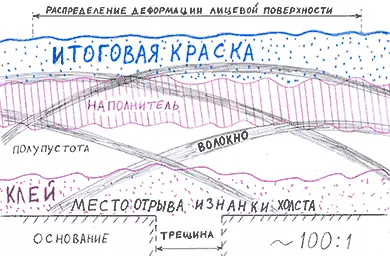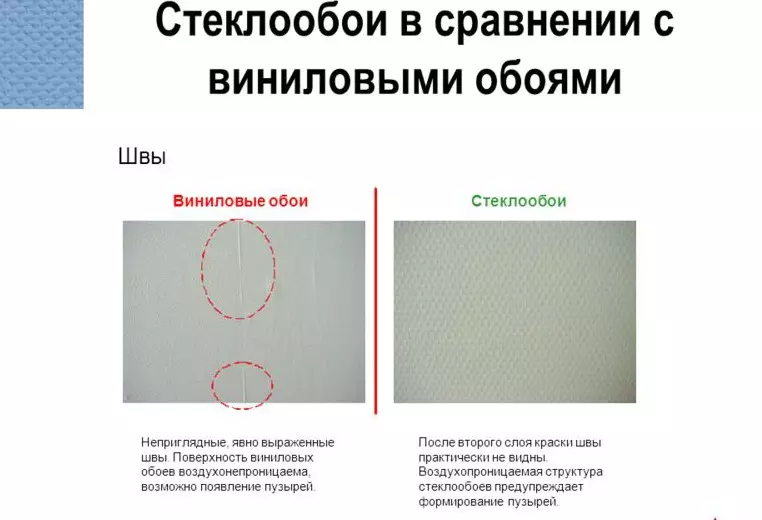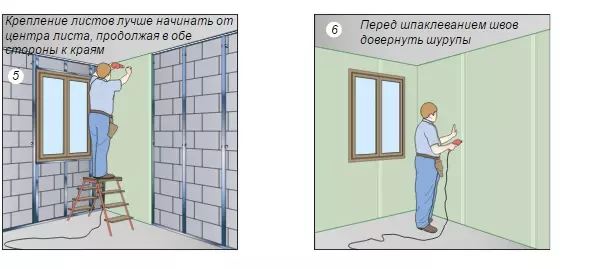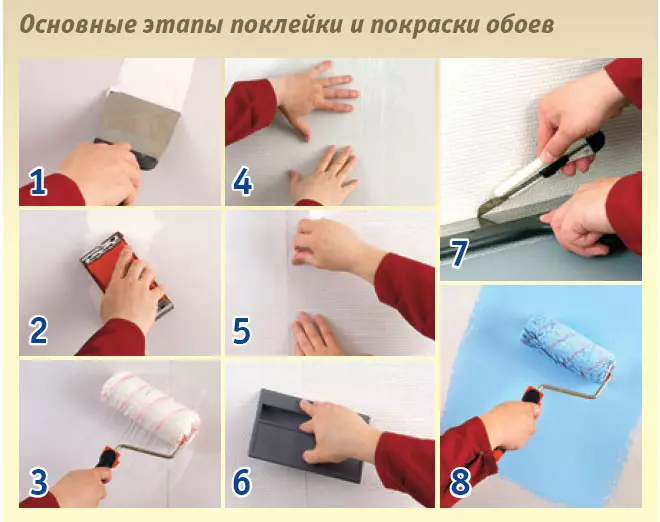Glassball is a modern material that is used to finish the walls of the room. It is a fabric of treated fiberglass, which is better and safe in comparison with synthetic materials. It is believed that the glasses perfectly grind all small wall defects, but they are still recommended to glue them on the perfectly smooth surface, for example, on plasterboard.

Structure of glass cholester.
This material is still used not as often as paper and vinyl wallpapers, but on the technique of laying it is not much different from them. It is possible to glue it with a wallpaper glue, observing the absence of drafts indoors. With such work, it is recommended that it is precisely plasterboard, as it guarantees a smooth surface without curvature and flaws.
Glassy: Benefits and Fashion Beef
Such material as glass windows differs in the following advantages:
- Ecology. The material is made of natural raw materials on special technology, which makes it absolutely safe.
- Non-hatching. Wallpaper from fiberglass do not ignite, when heated does not distinguish harmful substances.
- Highest strength. The resistance to the glasses of glasses is about twice as much as vinyl.
- Long service life. The cost of such wallpapers is large enough, but it fully pays off with simple installation and service life of thirty years.
- The decoration material made of fiberglass and resistance to moisture, which makes it an ideal option for kitchens and bathrooms.
- If necessary, glass can be repeatedly repainted, while the material does not lose its properties and characteristics.

Comparative characteristic of glasses.
Glassball is usually glued in such a way that the joints are not visible. For this, about 2-3 mm gap leaves between the individual strips, which then swells and is cleaned. After that, the glass windows are covered with a layer of paint and all joints become simply invisible. But when the lateral light, ugly dark stripes with a width of up to 5-10 cm are visible. This is due to the fact that at stripping, the sandy paper flies the fiberglass layer, disturbing its structure, such a bar does not reflect the light.
The second method is the usual, without leaving the gap. All bands are pasted with a joint in the joint or with a small overlap, but with this method perpendicular to the incident light will also highlight the seams.
Article on the topic: Production technology of braided chairs do it yourself
Experts recommend that the source of natural and artificial lighting is taken into account in order to take the right decision regarding the choice of the method of sticking wallpaper wallpapers.
What is glued glassball?
In order to glue a glassball on a plasterboard surface, you can use wallpaper glue, but it is best to buy formulations intended for glasskeeping. Why? The fact is that many dry mixtures contain starch, and it does not keep glazed well, so you should choose the mixture in such a way that it contains PVA, but in the divorced state.In some cases, the masters recommend using putty, but this is fraught with such a nuisance as a web from the material assemblies and air bubbles. The putty is even very liquid does not impregnate the glass cholester to the base, so it will quickly start to spin. In the process of laying the web, the canvas will have to be wateted with water, and it may not affect both wallpaper and plasterboard.
When choosing an adhesive tool, pay attention to the composition, the purpose of glue. It is better to immediately overpay a small amount and take more expensive glue than then fully change the glassball to the new one.
Preparation of walls for glass cholester

Installation of plasterboard sheets on the frame.
Before glitching glass windows on plasterboard, the wall must be prepared. It is necessary to completely remove the old coating, clean the wall from the garbage, to carry out leveling operation if plasterboard under the glass windows will be mounted by a frameless method. After laying, the GLK is required to carefully sharpen the surface, as the glass cholester requires a perfectly smooth wall, the layer of putty is best to apply all over the sheet so that the seams do not shine after the stickers.
Before glue the wallpaper, it is recommended to apply a layer of primer into two layers after drying the putty. This is done so that the glass windows do not dug during operation.
It is important to properly prepare the conditions for work, glittering glass walls can only be indoorated with a temperature of + 10-25 ° C, all windows need to close tightly. When sticking and drying, the glass windows do not like drafts and direct sunlight.
Article on the topic: Stucco on the facades of houses, a lightweight version of a heavy decor
Cars of plasterboard walls: instruction
Glue glassball on the surface of the drywall is quite simple, for this you do not need to be a large specialist. But still some stages must be observed. We offer step-by-step instructions, as possible and quickly shove the glass windows on a plasterboard sheet:
- The surface of the sheets of GLC is covered with a layer of putty, special attention should be paid to the joints. All irregularities should be sealed with the main surface. It is desirable that the layer of putty fully covered the entire sheet. The layer should be not only even, but relatively thin, after applying it must be left to dry (the time depends on the type of mixture and the layer thickness.
- So that the glass cholester lay down smoothly and beautiful, it is recommended to smoke with sickle. It also applies to small cracks, fasteners, which become imperceptible against the rest of the plates. Sherryanka is a tape with a small width made of fiberglass, in its structure, it looks like a regular medical bandage, only in this case there is also an impregnating adhesive special substance.
- Next, the surface of the plasterboard is processed by sandpaper so that there are no irregularities on the wall. This will make the process of sticking easier, fast and high quality.
- The next step is to cover the GLC primer so that glue for wallpaper is not absorbed into the wall. If this is not done, then the glass cholester will very quickly begin to lag from the plasterboard surface. For reliability, many experts recommend to apply two layers of primer, but at the same time the first must finally dry before apply the second, drywall in this case holds the wallpaper.

Punning and painting of glasses.
The glassball starts to glue only after the final drying of the wall. To properly determine the amount of material before the start of all works, the wall is measured, for this it takes the length of the floor to the ceiling, is multiplied by the number of walls. Employ no need!
Do not forget about the percentage of climbing, which is about 10%. The glassball is glued to the wallpaper glue, which today you can buy in the form of a dry mixture that is bred by ordinary water. The technology of the adhesive itself is no different from the other types of wallpaper, the glue is pre-remains for swelling, the sheets of glass fuses are rolled along a flat and clean surface (free from the floor in the room where the work is performed).
With the help of a brush or roller, the finished adhesive composition is applied to the wrong surface of the material, after which the glass windows are pasted on plasterboard.
To properly stick a glassball on a plasterboard wall, you need to prepare such tools and materials as:
- Glass equipment in the calculated quantity (how to calculate the material, indicated above);
- Roulette, simple pencil and scissors;
- glue for wallpaper;
- Capacity for dilution of glue, brush or roller;
- pure rag;
- Dry roller or rag for smoothing wallpaper.
Article on the topic: Compact toilet - an ideal solution for a small bathroom
Possible problems and rules
Using glass windows for trimming of plasterboard walls, you can face such problems as:
- The surface of the wall should be perfectly smooth, that is, when installing drywall.
- All joints and fastening sites of self-tapping screws should be carefully covered, otherwise every irregularity will be noticeable, which will greatly worsen the appearance of the wallpaper.
- With an insufficient thickness of the glass cholester, drywall, or rather its seams, it starts to be strongly expressed. To help here there can be a way of spitting not only the junctions, but also the entire surface of the plasterboard sheets so that it becomes homogeneous in color.
- When the glass chill sticker on the plasterboard, it is important to comply with the conditions for the care of the material during operation. It often happens that in the repair process, the surface of the wallpaper was blicked. If a putty was used before that, it can be laundered.
- Gymelomes are recommended after stickers to paint so that the fiber particles that will be formed during touches are not irritated to the eyes and skin. In addition, this surface is much easier to clean.
The use of different types of wallpaper wallpapers is the most common type of decorative work. Wallpaper will help create a cozy atmosphere, they are easy to pick up for any interior, some species can be painted. Glass equipment occupy a special place among such coatings for the walls. They are durable and attractive, their value is available to many. In addition, these coatings can be repainted if desired. It is recommended to glue the wallpaper for pre-prepared plasterboard, as in this case the necessary preparation of the surface for the salary is achieved. The process of sticking wallpaper from fiberglass is very simple, does not take much time, care for wallpaper does not cause difficulties.
